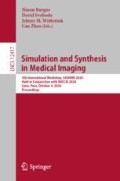Abstract
Simulating a large set of medical images with variability in anatomical representation and image appearance has the potential to provide solutions for addressing the scarcity of properly annotated data in medical image analysis research. However, due to the complexity of modeling the imaging procedure and lack of accuracy and flexibility in anatomical models, available solutions in this area are limited. In this paper, we investigate the feasibility of simulating diversified cardiac magnetic resonance (CMR) images on virtual male and female subjects of the eXtended Cardiac and Torso phantoms (XCAT) with variable anatomical representation. Taking advantage of the flexibility of the XCAT phantoms, we create virtual subjects comprising different body sizes, heart volumes, and orientations to account for natural variability among patients. To resemble inherent image quality and contrast variability in data, we vary acquisition parameters together with MR tissue properties to simulate diverse-looking images. The database includes 3240 CMR images of 30 male and 30 female subjects. To assess the usefulness of such data, we train a segmentation model with the simulated images and fine-tune it on a small subset of real data. Our experiment results show that we can reduce the number of real data by almost 80\(\%\) while retaining the accuracy of the prediction using models pre-trained on simulated images, as well as achieve a better performance in terms of generalization to varying contrast. Thus, our simulated database serves as a promising solution to address the current challenges in medical imaging and could aid the inclusion of automated solutions in clinical routines.
Y. Al Khalil and S. Amirrajab—Contributed equally.
Access this chapter
Tax calculation will be finalised at checkout
Purchases are for personal use only
Notes
- 1.
The simulated database will be available online for medical imaging research.
References
Abbasi-Sureshjani, S., Amirrajab, S., Lorenz, C., Weese, J., Pluim, J., Breeuwer, M.: 4D semantic cardiac magnetic resonance image synthesis on XCAT anatomical model. In: Medical Imaging with Deep Learning (2020)
Abraham, N., Khan, N.M.: A novel focal Tversky loss function with improved attention U-Net for lesion segmentation. In: 2019 IEEE 16th International Symposium on Biomedical Imaging (ISBI 2019), pp. 683–687. IEEE (2019)
Bernard, O., Lalande, A., Zotti, C., Cervenansky, F., et al.: Deep learning techniques for automatic MRI cardiac multi-structures segmentation and diagnosis: is the problem solved? IEEE Trans. Med. Imaging 37(11), 2514–2525 (2018)
Bojorquez, J.Z., Bricq, S., Acquitter, C., Brunotte, F., Walker, P.M., Lalande, A.: What are normal relaxation times of tissues at 3 T? Magn. Reson. Imaging 35, 69–80 (2017)
Chartsias, A., Joyce, T., Dharmakumar, R., Tsaftaris, S.A.: Adversarial image synthesis for unpaired multi-modal cardiac data. In: Tsaftaris, S.A., Gooya, A., Frangi, A.F., Prince, J.L. (eds.) SASHIMI 2017. LNCS, vol. 10557, pp. 3–13. Springer, Cham (2017). https://doi.org/10.1007/978-3-319-68127-6_1
Frangi, A.F., Tsaftaris, S.A., Prince, J.L.: Simulation and synthesis in medical imaging. IEEE Trans. Med. Imaging 37(3), 673 (2018)
Goodfellow, I., Pouget-Abadie, J., Mirza, M., Xu, B., et al.: Generative adversarial nets. In: Advances in Neural Information Processing Systems, vol. 27, pp. 2672–2680. Curran Associates, Inc. (2014)
He, K., Zhang, X., Ren, S., Sun, J.: Delving deep into rectifiers: surpassing human-level performance on ImageNet classification. In: Proceedings of the IEEE International Conference on Computer Vision, pp. 1026–1034 (2015)
Joyce, T., Kozerke, S.: 3D medical image synthesis by factorised representation and deformable model learning. In: Burgos, N., Gooya, A., Svoboda, D. (eds.) SASHIMI 2019. LNCS, vol. 11827, pp. 110–119. Springer, Cham (2019). https://doi.org/10.1007/978-3-030-32778-1_12
Razzak, M.I., Naz, S., Zaib, A.: Deep learning for medical image processing: overview, challenges and the future. In: Dey, N., Ashour, A.S., Borra, S. (eds.) Classification in BioApps. LNCVB, vol. 26, pp. 323–350. Springer, Cham (2018). https://doi.org/10.1007/978-3-319-65981-7_12
Segars, W., Sturgeon, G., Mendonca, S., Grimes, J., Tsui, B.M.: 4D XCAT phantom for multimodality imaging research. Med. Phys. 37(9), 4902–4915 (2010)
Stanisz, G.J., et al.: T1, T2 relaxation and magnetization transfer in tissue at 3T. Magn. Reson. Med. Official J. Int. Soc. Magn. Reson. Med. 54(3), 507–512 (2005)
Suzuki, K.: Overview of deep learning in medical imaging. Radiol. Phys. Technol. 10(3), 257–273 (2017). https://doi.org/10.1007/s12194-017-0406-5
Wissmann, L., Santelli, C., Segars, W.P., Kozerke, S.: MRXCAT: realistic numerical phantoms for cardiovascular magnetic resonance. J. Cardiovasc. Magn. Reson. 16(1), 63 (2014)
Yi, X., Walia, E., Babyn, P.: Generative adversarial network in medical imaging: a review. Med. Image Anal. 58, 101552 (2019)
Acknowledgments
This research is a part of the openGTN project, supported by the European Union in the Marie Curie Innovative Training Networks (ITN) fellowship program under project No. 764465.
Author information
Authors and Affiliations
Corresponding author
Editor information
Editors and Affiliations
Rights and permissions
Copyright information
© 2020 Springer Nature Switzerland AG
About this paper
Cite this paper
Al Khalil, Y., Amirrajab, S., Lorenz, C., Weese, J., Breeuwer, M. (2020). Heterogeneous Virtual Population of Simulated CMR Images for Improving the Generalization of Cardiac Segmentation Algorithms. In: Burgos, N., Svoboda, D., Wolterink, J.M., Zhao, C. (eds) Simulation and Synthesis in Medical Imaging. SASHIMI 2020. Lecture Notes in Computer Science(), vol 12417. Springer, Cham. https://doi.org/10.1007/978-3-030-59520-3_8
Download citation
DOI: https://doi.org/10.1007/978-3-030-59520-3_8
Published:
Publisher Name: Springer, Cham
Print ISBN: 978-3-030-59519-7
Online ISBN: 978-3-030-59520-3
eBook Packages: Computer ScienceComputer Science (R0)


